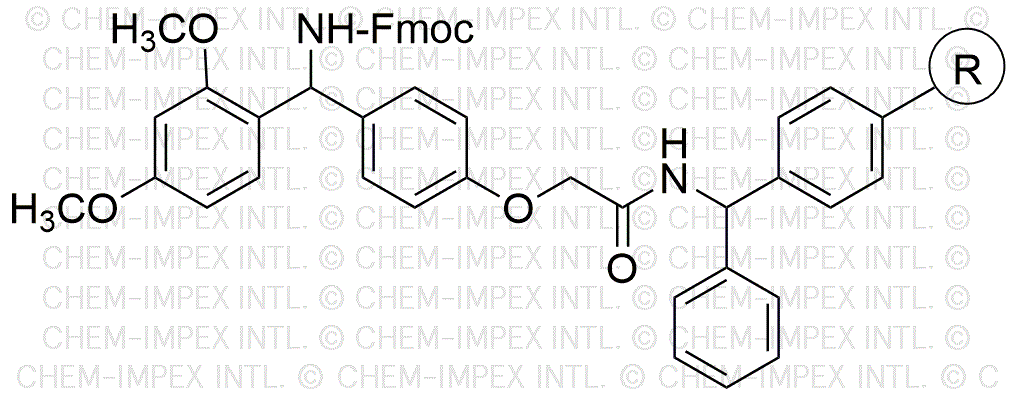4-(2', 4'-Dimethoxyphenyl-Fmoc-aminomethyl)-phenoxyacetamino-BHA resin is widely utilized in research focused on:
- Peptide Synthesis: This resin is essential in solid-phase peptide synthesis, allowing researchers to create complex peptides efficiently. Its high loading capacity ensures that a significant amount of peptide can be synthesized in a single batch.
- Drug Development: In pharmaceutical research, this resin aids in the development of peptide-based drugs, which are crucial for targeting specific biological pathways. Its ability to facilitate the attachment of various functional groups enhances drug design flexibility.
- Bioconjugation: The resin is used for bioconjugation processes, where it helps in attaching biomolecules to surfaces or other molecules. This is particularly useful in creating targeted therapies and diagnostic tools.
- Material Science: In the field of material science, this resin can be utilized to develop new polymeric materials with tailored properties, contributing to advancements in coatings, adhesives, and composites.
- Research in Cancer Therapeutics: The compound is being explored in cancer research for its potential to create targeted therapies that can deliver drugs directly to cancer cells, minimizing side effects and improving treatment efficacy.
General Information
Properties
Safety and Regulations
Applications
4-(2', 4'-Dimethoxyphenyl-Fmoc-aminomethyl)-phenoxyacetamino-BHA resin is widely utilized in research focused on:
- Peptide Synthesis: This resin is essential in solid-phase peptide synthesis, allowing researchers to create complex peptides efficiently. Its high loading capacity ensures that a significant amount of peptide can be synthesized in a single batch.
- Drug Development: In pharmaceutical research, this resin aids in the development of peptide-based drugs, which are crucial for targeting specific biological pathways. Its ability to facilitate the attachment of various functional groups enhances drug design flexibility.
- Bioconjugation: The resin is used for bioconjugation processes, where it helps in attaching biomolecules to surfaces or other molecules. This is particularly useful in creating targeted therapies and diagnostic tools.
- Material Science: In the field of material science, this resin can be utilized to develop new polymeric materials with tailored properties, contributing to advancements in coatings, adhesives, and composites.
- Research in Cancer Therapeutics: The compound is being explored in cancer research for its potential to create targeted therapies that can deliver drugs directly to cancer cells, minimizing side effects and improving treatment efficacy.
Documents
Safety Data Sheets (SDS)
The SDS provides comprehensive safety information on handling, storage, and disposal of the product.
Product Specification (PS)
The PS provides a comprehensive breakdown of the product’s properties, including chemical composition, physical state, purity, and storage requirements. It also details acceptable quality ranges and the product's intended applications.
Certificates of Analysis (COA)
Search for Certificates of Analysis (COA) by entering the products Lot Number. Lot and Batch Numbers can be found on a product’s label following the words ‘Lot’ or ‘Batch’.
*Catalog Number
*Lot Number
Certificates Of Origin (COO)
This COO confirms the country where the product was manufactured, and also details the materials and components used in it and whether it is derived from natural, synthetic, or other specific sources. This certificate may be required for customs, trade, and regulatory compliance.
*Catalog Number
*Lot Number
Safety Data Sheets (SDS)
The SDS provides comprehensive safety information on handling, storage, and disposal of the product.
DownloadProduct Specification (PS)
The PS provides a comprehensive breakdown of the product’s properties, including chemical composition, physical state, purity, and storage requirements. It also details acceptable quality ranges and the product's intended applications.
DownloadCertificates of Analysis (COA)
Search for Certificates of Analysis (COA) by entering the products Lot Number. Lot and Batch Numbers can be found on a product’s label following the words ‘Lot’ or ‘Batch’.
*Catalog Number
*Lot Number
Certificates Of Origin (COO)
This COO confirms the country where the product was manufactured, and also details the materials and components used in it and whether it is derived from natural, synthetic, or other specific sources. This certificate may be required for customs, trade, and regulatory compliance.

